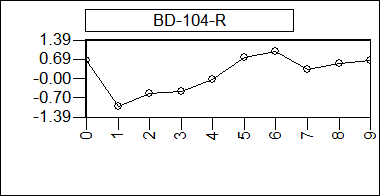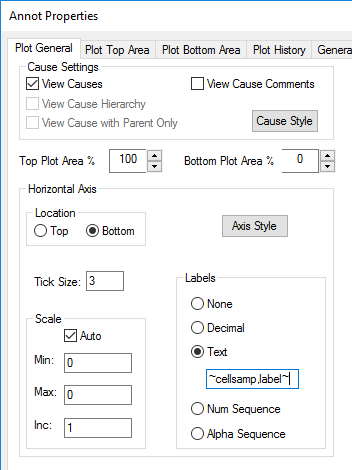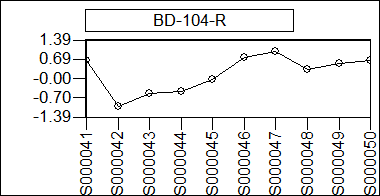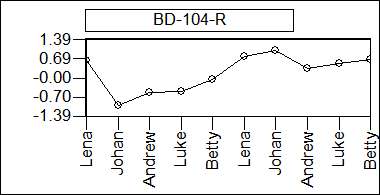See here for bug fixes.
CM4D v25.0.21182
- CM4D Db Schema: 25b
Wireframe (WYR) Image Support Re-introduced
With the introduction of the HOOPS engine in v25, support for some older image types were discontinued. However, in this version support for 3D wireframe models has been re-introduced. This includes settings for wire overrides in CM4D image properties.
Document Properties - Feature Marker Colors
Feature marker default colors can be set on the document properties. The color can either be set using a dropdown color picker, or the colors can be defined in the Cm4D.ini file. If these are defined in the INI file, the color values are copied into the document on creation. On existing documents, the values can be reset to values saved in the INI file.
See here for more information.
New Variables for Chart Axis Labels
In charts using a query with multiple Routines, chart axis labels show the DataSet column number when the Sample labels cannot be resolved.

New variables have been added that can be used in the axis label field that will properly resolve for multiple Routines:
- ~cellsamp,label~
- ~cellsamp,filter,[a-z]~
For DataSets with multiple Routines, these variables will resolve the chart axis as the Sample Label or Filter Label instead of the DataSet column number. This is best used with either a single feature or with Routines that have corresponding samples.
 |
~cellsamp,label~ | |
 |
||
| ~cellsamp,filter,c~ | ||
 |
See here for more information.
New QaDataSource API Functions
The following properties of QaDataSource have been added:
- UseDataSetFeature => true selects Use Feature
- DataSetFeatureLabel => set/get the Feature for a DataSet
- DataSetFeatureChr => set/get the characteristic
See here for more information.
CM4D v25.0.20136.1
General Notes
- Site Db Schema: 25b
- CM4D Db Schema: 25a
- TLS 1.2
CM4D Roadmap
Interested in the CM4D development roadmap? Visit: https://cm4d.roadmap.ats-global.com/
Improved 3D Visualization Technology
CM4D has had 3D visualization since its inception in 1991. Over the years, we have had four generations of 3D visualization built into the product.
HOOPS Engine
The next generation of technology provides state-of-the-art 3D viewing and interaction capabilities. The initial implementation includes functionality such as:
- Improved visualization quality
- Improved tool set
- Direct import of CAD model
CM4D image formats XGL and WYR are no longer supported. See here for a list of supported 3D file types.
Cutting Planes
The 3D HOOPS engine has built-in interactive cutting plane support and automatically generates “capping geometry” for closed meshes. It also supports aggregating cutting planes into sectioning planes to slice through and cut-out parts of a model. See here for more information.
Display Modes
Display Modes are different ways that CM4D can draw the model in a View. Switching the display mode is an easy way to turn off visibility of faces and lines for the whole model, make Feature markers more prominent or to provide a result suitable for hardcopy or screenshots. See here for more information.
Transparency
Updated transparency settings provide a sliding scale from solid to transparent. See here for more information.
3D Feature Markers
Features with vectors have a 3D marker that is unique for the feature type. This version introduces Surface, Hole, and Slot. Constructed Features Midpoint and Distance also have a unique marker.
Optional Results Database
Using the Results Database is now optional. If you do not want to setup and use Results, you can disable the option at the Site database level. When the Results database is disabled, results messages will not be generated and the results services are not used.
Without the Results database configured you will miss out on the benefits of a high-performance repository of information available for business analysis.
In future versions of the product, the Results data will be a key part of the development path and a requirement for some new CM4D applications.
Report Manager in Classic
Added a mechanism to administrate Managed Reports in CM4D. Document managers can create, modify and delete Managed Reports using CM4D Classic. This allows you to manage reports directly within the CM4D environment, rather than requiring the addition of CM4D Web. See here for more information.
Show/Hide Sheet Border
An option has been added to the SheetSet properties to show or hide the border of a Sheet in CM4D. See here for more information.
CM4D Version Formatting
*Current year (two-digits) and the number of days since the beginning of the year.
|
Major version |
Patch version |
Julian Date* |
Build Number |
|
24 |
1 |
19207 |
1 |
See here to see the release notes for previous versions.